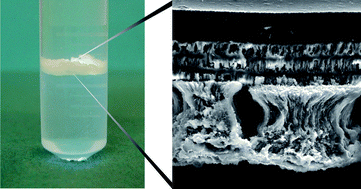Polyelectrolyte–surfactant nanocomposite membranes formed at a liquid–liquid interface†
Abstract
There are three main methods for constructing polyelectrolyte–

* Corresponding authors
a
School of Chemistry, University of Bristol, Bristol, UK
E-mail:
ian.manners@bristol.ac.uk
Tel: +44 (0)117 928 7650
b
Department of Biochemistry, University of Bristol, Bristol, UK
E-mail:
d.n.woolfson@bristol.ac.uk
Fax: +44 (0)117 925 1295
Tel: +44 (0)117 928 7645
There are three main methods for constructing polyelectrolyte–

 Please wait while we load your content...
Something went wrong. Try again?
Please wait while we load your content...
Something went wrong. Try again?
D. B. Carew, K. J. Channon, I. Manners and D. N. Woolfson, Soft Matter, 2011, 7, 3475 DOI: 10.1039/C0SM01075H
To request permission to reproduce material from this article, please go to the Copyright Clearance Center request page.
If you are an author contributing to an RSC publication, you do not need to request permission provided correct acknowledgement is given.
If you are the author of this article, you do not need to request permission to reproduce figures and diagrams provided correct acknowledgement is given. If you want to reproduce the whole article in a third-party publication (excluding your thesis/dissertation for which permission is not required) please go to the Copyright Clearance Center request page.
Read more about how to correctly acknowledge RSC content.
 Fetching data from CrossRef.
Fetching data from CrossRef.
This may take some time to load.
Loading related content
